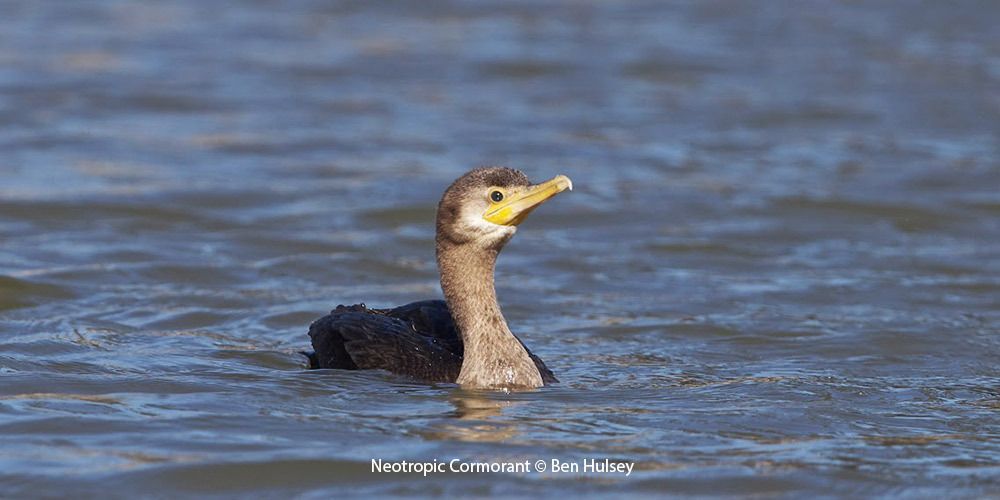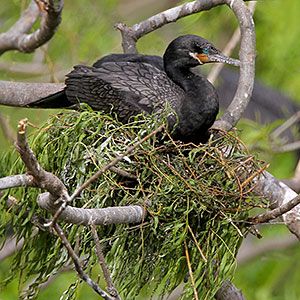
© Joanne Kamo. Photographed at Smith Oaks Rookery.
Neotropic Cormorant
Nannopterum brasilianum
Family: (Phalacrocoracidae) Cormorants
Preferred Habitat: Lakes and ponds.
Seasonal Occurrence: Very common March through September. Somewhat less common in winter.
Profile by Gislaine Peters: The Neotropic Cormorant is medium-sized cormorant, at about 25 inches in length. Throughout the year they can mainly be found along the Gulf Coast of Louisiana and Texas as well as Central and South America. Occasionally they will journey up into the Great Plains region. They can be found along rivers, lakes, marshes and seacoasts. The adults are black with some olive gloss at the back and wings. The throat patches of the adults are dull yellow and have white border during the breeding season. They have a medium sized bill that has a hook at the tip. Immature Neotropic Cormorants are mainly brown on their breast and neck.
They nest in groups called colonies and construct their nest in bushes and trees around 3-25’ above the water as well as on the ground of islands in bays. Unlike most waterbirds in Texas, the Neotropic Cormorant will nest in both late Spring and in Fall when prey availability is sufficient. Their nests are made of sticks shaped into a bowl. The clutch size of their light blue eggs can range from between 1-5 but is often between 3-4. The eggs are incubated by both adults for approximately 25-30 days. When the young hatch they are fed by their parents until roughly 11 weeks of age. At 8 weeks they are usually able to swim and dive.
Neotropic Cormorants dive to catch small fish; their typical prey ranges from 2-5”. They will also eat tadpoles, frogs and aquatic insects. In Mexico they have been observed fishing cooperatively. They will form a line across swift-flowing streams and strike the surface of the water with their wings. This causes the fish to attempt to flee allowing the cormorants to dive and catch them.
Neotropic Cormorants can often be seen year around at our Smith Oaks Rookery, come on down and see for yourself!
Profile by Charlie Ayers: When birding near any body of water, be on the lookout for this small, slim, nearly all black bird with a long tail, large webbed feet and a thin straight bill with a hook on the end. However, this may not be enough to help you identify a Neotropic Cormorant. This is because, much to a birder’s dismay, there are two other species that look similar to the Neotropic Cormorant - the Double-crested Cormorant and the Anhinga. The first step to separating the three species is size. Neotropic Cormorants are about half the size of Double-crested Cormorants and Anhingas. An easy way to remember this is that Double-crested Cormorants are double the size of a Neotropic Cormorant. If you aren’t confident on size, the next step is to look at the face. Adult Neotropic Cormorants have a thin white line on their chin, white tufts sprouting from where their ears would be, and a yellow bare patch of skin only below the beak. If you happen to come across a juvenile of the two cormorants, look for a very pale, almost white chest and belly; this is an indicator that you are seeing a Double-crested Cormorant.
Neotropic Cormorants perform an odd behavior for a bird living above the equator; they breed twice a year, once in the summer and a second time in the fall. Neotropic Cormorants, like many of our wading birds, will nest in a rookery, which is a colonial waterbird’s nesting location. These sites often contain hundreds to thousands of birds, and Smith Oaks Bird Sanctuary is the home to one of these special locations. If you go sit on the benches by Smith Pond at the sanctuary, you can see around 150 Neotropic Cormorant nests, many already containing eggs. The best time to go is an hour and a half before sunset as all the wading birds return to roost on the rookery for the night. It’s a truly spectacular event to watch as 4,000 birds of 10 different species come into roost all within the same two hours.
Neotropic Cormorants can be found through much of Central and South America, but they are much harder to see here in North America. Almost all of the birds found in the US live year-round in Texas with smaller populations found in neighboring states such as Louisiana, Arizona and New Mexico. Good places to see these birds are really anywhere with a good water source like Smith Oaks Bird Sanctuary, Bolivar Flats Bird Sanctuary and at the Shovelers Pond Loop at Anahuac National Wildlife Refuge.
-
Cornell Lab of Ornithology
-
Bird Guide
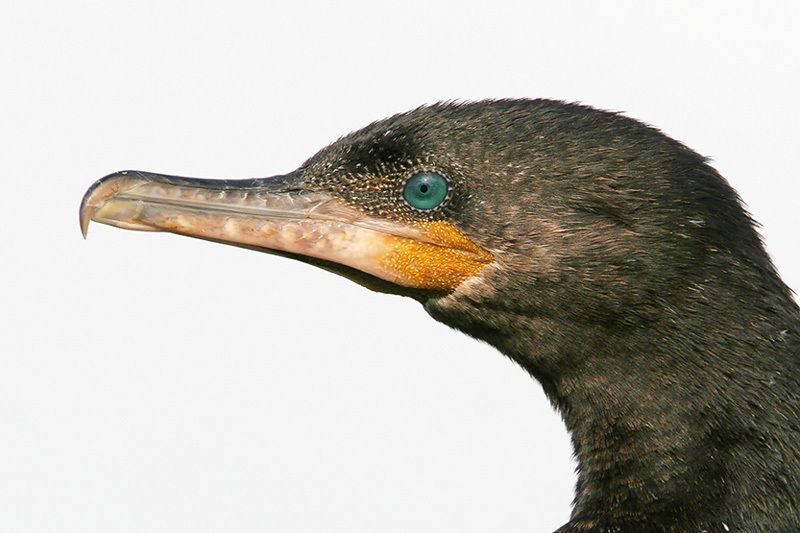
© Greg Lavaty, www.texastargetbirds.com
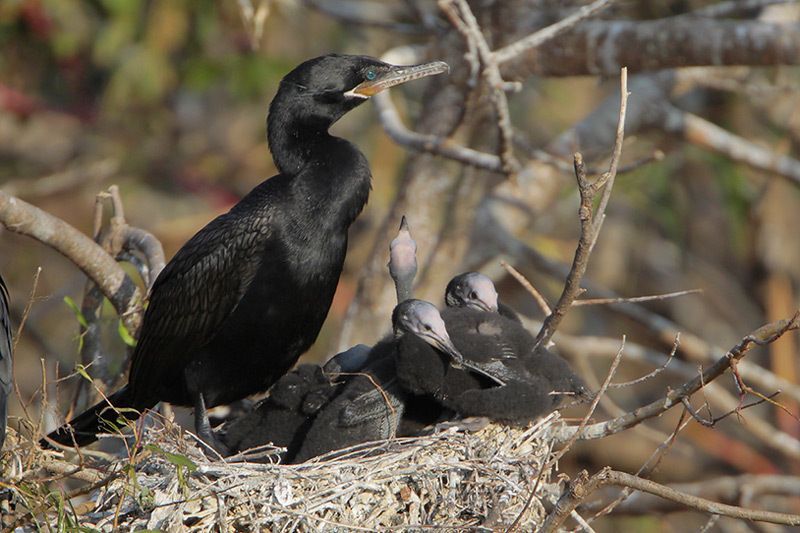
© Greg Lavaty, www.texastargetbirds.com
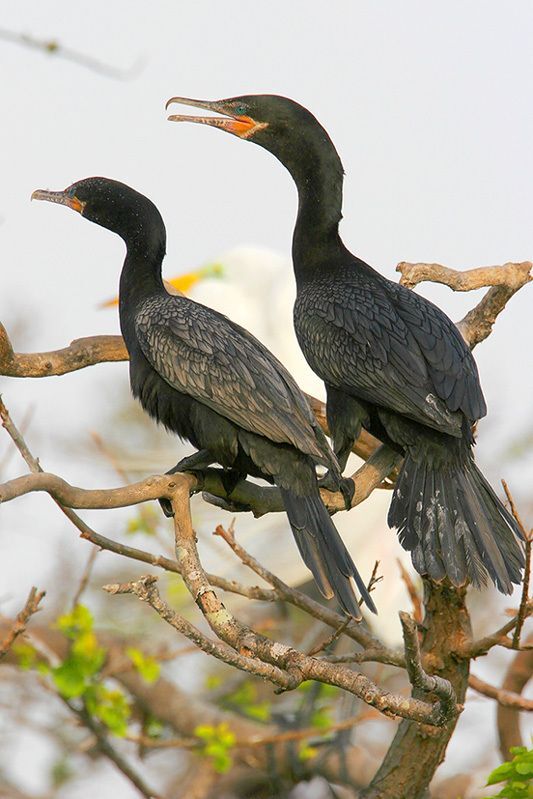
© Greg Lavaty, www.texastargetbirds.com

